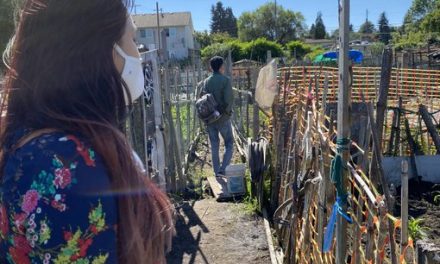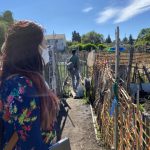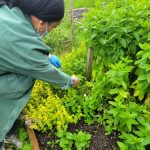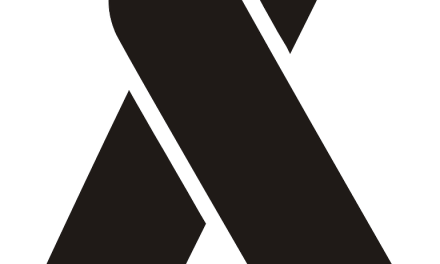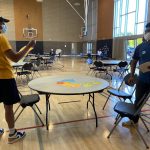
ADULTING 101: OVERCOMING FOOD INSECURITY IN RAINIER BEACH
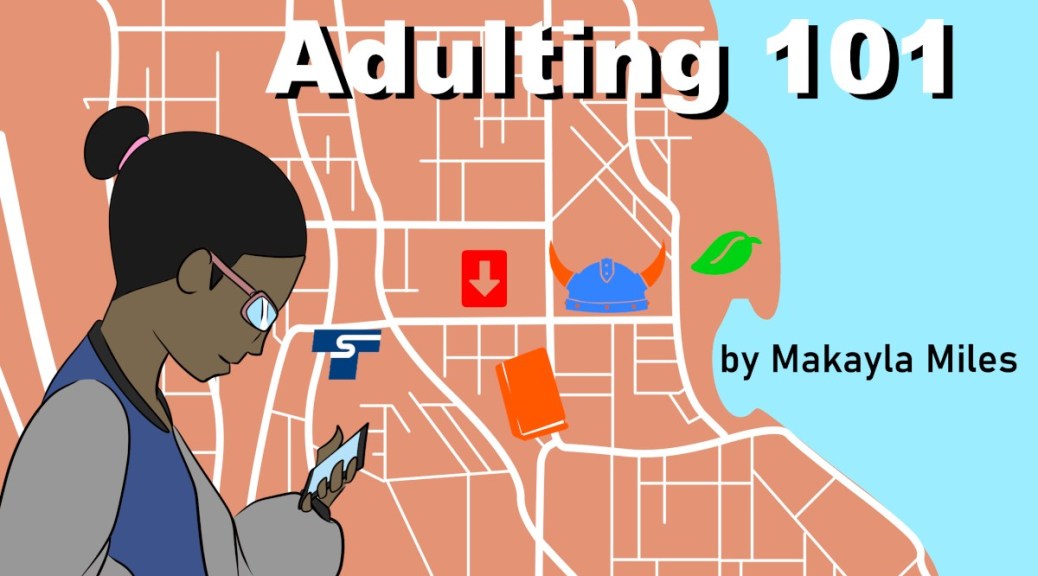
This is the second in a series of articles drawing from the experiences of the many young adults employed by the Rainier Beach Action Coalition (RBAC) to improve their community. Each article will tackle practical issues young adults in our community should have learned about in school but often leave school without knowing.
Every Saturday, at least a half-hour before the Rainier Beach Action Coalition Farm Stand officially opens, the line of people waiting to get their hands on fresh, organically grown produce stretches from in front of the Community Center all the way toward the entrance of South Shore K–8.
Food insecurity is defined as “the state of being without reliable access to a sufficient quantity of affordable, nutritious food.”
It’s widely known that Rainier Beach only has one grocery store — but while Safeway is a reliable option for some people, it can be too expensive for people living in low-income households. As a result, people sometimes have to travel outside of the area to find affordable food.
The Rainier Beach Farm Stand was founded in 2018. Before it existed, no farmers markets or farm stands existed in Rainier Beach. The Farm Stand accepts coupons and EBT and donates leftover produce to Ethiopian Community in Seattle (ECS) or the local food bank.
The Farm Stand was created to address the need for affordable produce in Rainier Beach. The Rainier Beach Farm Stand ran from June through October last year; because of the pandemic, last summer all Farm Stand food was free, and the long line showcased the extent of food insecurity in Rainier Beach. It’s difficult to access fresh, affordable produce here, and I wanted to explore how local youth respond to such a scarcity of options. I asked participants in YATTA Rising, Rainier Beach Action Coalition’s (RABC) Young Adults Transitioning to Adulthood program for ages 16–24, how they feel about Rainier Beach only having one grocery store.

Fatima: “I feel like that’s really a big problem. I feel like they should have, like before the Dollar Store, there was a market (Saars Super Saver). It was a good grocery store because it was affordable, and you could just get vegetables. That’s where my family used to go before Safeway because it was just affordable. Ever since that left, Safeway has been pricey, and that’s the only grocery store here, and I feel like that’s a struggle just having one grocery store in the South End.”
Hani: “It’s strange. I feel like the number of grocery stores says something about the accessibility of food. The fact that there is only one [grocery store] in Rainier Beach, especially in the pandemic … People would buy items, and these things would be out because there is only one store. It makes people think that this is the best they can get. It’s the only thing they can compare to, unless you go to North Seattle. It’s a battle for resources.”
Zion: “There are eight grocery stores in a mile and a half radius from where Hani and I are living now [in the Chinatown/International District (CID)]. So much proximity to food compared to just one option for a grocery store. Besides the Rainier Beach Safeway, there is the Halal store. They tore down Saars to build Planet Fitness. It’s wild. The quality of grocery stores in Rainier Beach is different from Little Saigon. There is QFC, Trader Joe’s, and PCC is nicer quality. It’s a drastic change.”
Messiah: “I think there could be a bit more variety or at least a little bit more healthy variety in it. I don’t have a particular gripe about our one grocery store being Safeway; it’s just all the other fast food places that are over here that I have more of a bone to pick with, because sure, we have like one grocery store that has some healthy foods in there. Still, it gets washed out if you have three or four or five different fast food places all in one condensed spot, you know? Yeah, I think that’s it. I don’t mind the one grocery store with only some moderate healthy foods. It’s just all the fast food options that are out there …”

Other South End grocery store chains include the Othello Safeway, Red Apple, QFC, and PCC (a Seattle-based co-op). In addition, the independent Seattle Supermarket (a Vietnamese-owned Chinese supermarket on Beacon Hill), Fou Lee (a Vietnamese-owned Filipino market), the Skyway Grocery Outlet, and Ba Mien Seafood Market near Othello Station complete South Enders’ other options.
Rainier Beach residents without a car will struggle to go grocery shopping using public transportation. The bus and the light rail will get you to these stores, but not easily. It takes around 30 minutes to get from Rainier Beach to PCC via the 7 or the 106. You can get to Red Apple by catching the 107 or on the light rail — but that will take at least 20 minutes each way. I decided to ask the YATTAs where they go grocery shopping and why they choose that particular store.
Zion: “My main grocery store is QFC, Safeway, and Viet-Wah [a branch of Vietnamese supermarket that’s now closed]. I can get discounts at Safeway by using a phone number, and Safeway is in close proximity. Viet-Wah Supermarket is cheap. There is affordable produce. I’ve been going to Viet-Wah since I was a kid. It was literally down the street. At times it was the only accessible grocery store. Safeway and Viet-Wah have always been the most accessible options.”
Hani: “I choose a grocery store I’m familiar with, like Safeway. I go to Costco to search for items in bulk. We just go to QFC. The proximity, how familiar we are with the place, and our experience with the place. Affordability. If our experience wasn’t great, we aren’t coming back. I’m tired of going to grocery stores and spending 70 like dollars.”
Fatima: “Well, usually we go shopping at Costco because we are a big family. We usually go to Costco to get our groceries and things that we need, but if it’s like an emergency and we need something like as soon as possible, we’ll go to Safeway because it’s right across from my house. We’ll just walk to Safeway, but Safeway is pricey on their stuff, and it’s like, it shouldn’t be that expensive. So expensive, it’s like they want all my money.”
Messiah: “It’s usually 90% [shopping at Safeway]. Because I live right across the street from it, I can see it from my bedroom windows. And you know, it’s the easiest and fastest way to get groceries.”
According to Northwest Harvest, 1 in 10 Washingtonians consistently struggle with hunger, and 1 in 8 Washingtonians rely on the Supplemental Nutrition Assistance Program (SNAP) to purchase food. Half of all people on SNAP are kids. Two out of the four YATTAs I interviewed say they have experienced food insecurity. One of the YATTAs said that having school food helped her family with food insecurity. Another YATTA noted that the food boxes being given out currently ensure that their household is getting enough food.
Zion: “Even though I was in the South End, there were times when it was hard for us financially, but my mom always made sure that we had food on the table. Living alone in the pandemic, plus the lack of hours, I had to figure it out for myself: the first month and last month’s rent. I was ready to be hungry. By the grace of God, the City of Seattle had emergency food vouchers for $300. That saved my life.”
Shopping and Eating Smart
Before you go grocery shopping, check your fridge and cupboards to see the items you already have; that way, you only buy what you need. Making a meal plan and a shopping list is a way to ensure you get everything you need.
Most grocery stores provide loyalty cards that allow you to get discounts on groceries. Safeway has an app called “just for U” that gives you personalized discounts. QFC offers an advantage card that gives you access to coupons. Red Apple‘s website has coupons and weekly ads that will enable you to see what’s on sale.
Even though food insecurity is a serious problem, so is food waste. According to the USDA, 40% of the food in the United States goes to waste. Luckily there are tips and tricks to make your food last longer. This storage guide from Seattle Public Utilities shows you where you can store fruits and vegetables to give them a longer life. Here are some of the highlights:
- You should store apples in the fridge away from other produce.
- Cabbages, oranges, bell peppers, broccoli (wrapped in a damp towel), cucumbers, and eggplants stored in the refrigerator crisper drawers will last longer.
- Cantaloupe, apricots, honeydew, kiwi, mangoes, peaches, pears, pineapples, plums, when ripened, can be stored in the refrigerator.
- If you have leftovers, you can freeze them and save them for a later date.
Food Resources
If you are struggling to find food, there are resources available. You can see if you qualify and apply for state assistance here. Seattle Public Schools is offering food to parents and students. The Rainier Valley Food Bank is partnering with Food Lifeline to give out food boxes every Wednesday from 10 a.m.to 1 p.m. at the Rainier Beach Community Center. Seattle Community Kitchen Collective is providing free hot meals on Mondays and Tuesdays from 12 to 4 p.m. Food is first come, first served; call in and pick up. Tilth Alliance is offering their Good Food Bags program; members sign up to get weekly or bi-weekly bags of fresh, sustainably grown local produce for just $5. They accept payments by credit card, debit, and EBT. Sign up on their Market Programs website. They also have a farm stand that runs from June 17 to Sept. 20, on Thursdays from 2 to 7 p.m. The farm stand accepts cash, credit/debit cards, EBT, Fresh Bucks, WIC, and Senior Farmers Market vouchers, and offers a SNAP Match 50% off discount.
Creating a Food Secure Rainier Beach
Lastly, we asked the YATTAs how Rainier Beach as a community can improve access to fresh, affordable produce and healthy food.

Fatima: “I would say having more grocery stores. Like my dream is to, I want to have my own Black-owned business that has affordable things. You know, it’s hard for single mothers to provide for their kids and take care of their kids and make sure that they go to sleep with a full stomach every night. I would make sure when they come to my market, it is so affordable and it is easy [to] access … Just having more markets in the South End will be really, really great.”
Hani: “I think for one, it would be great to have some food assistance. I mean, like when LaTanya was here, she would give us packages of vegetables, and it helped my sister and me when we just moved in; we couldn’t spend that much money on groceries and stuff. It was a huge help to have that delivered. It was free and much appreciated. Just free food like to be able to give that to the community. I know that there is a garden so maybe like, you know, providing free food from there or the farms and like after your business, maybe like for the business day, you can give some of that to the community, out into the community would just help a lot. I think providing that would also like to help people you know to put more trust in us and like what we do and support us more, because you know we’re supporting them in the way they’re supporting our living. So I think that would be a good idea.”
Messiah: “I think the best way to do that is to have more events similar to the Farm Stand or even just more farmers markets. Because I think that farmers markets, most of the food over there it’s incredibly healthy and like locally grown; how affordable it usually depends on which farmers market you go to, but the fact that we have the Farm Stand. Every year, that’s already a huge step in the right direction. So if he can get other programs or markets like that, I think that’s the hurdle to leap over or like the next hurdle to leap over.”

